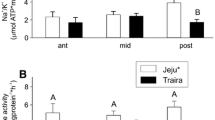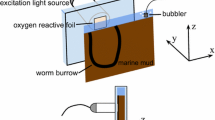Abstract
The isopod Natatolana borealis Lilljeborg constructs U-shaped burrows in soft mud, the bore of which closely approximates the width of the occupant. Within artificial burrows, the isopods are largely quiescent and often adopt a position close to one of the burrow openings. Conditions within burrows constructed in the laboratory are moderately hypoxic [11.7 to 14.9 kPa (88 to 112 torr)], with isopods showing discontinuous irrigation behaviour (pleopod beating). Rates of oxygen consumption \((\dot M_{O_2 } )\) (measured at 10°C) are maintained approximately constant over a wide range of oxygen partial pressure (PO 2) due, in part, to a pronounced increase in pleopod beat rate. Values for the “critical” partial pressure of oxygen (Pc), the PO 2 at which \(\dot M_{O_2 } \) can no longer be maintained independent of PO 2, were 2.0 to 3.3 kPa (15 to 25 torr). N. borealis can survive lengthy periods (65 h at 5°C) of anoxia, during which there is a significant reduction in the carbohydrate concentration and an increase in the l-lactate concentration of the tissues. The oxygencarrying capacity of the haemolymph of N. borealis was low. The haemocyanin showed a relatively high oxygen affinity [P50=0.39 kPa (2.99 torr) at 10°C at the in vivo pH of 7.80] and a pronounced Bohr effect (-1.22). These characteristics may be advantageous to a burrowing mode of life and also for the conditions likely to be encountered in fish carcasses into which they burrow en masse to feed.
Similar content being viewed by others
References
Anderson SJ, Atkinson RJA, Taylor AC (1991) Behavioural and respiratory adaptations of the mud-burrowing shrimp Calocaris macandreae Bell (Thalassinidea Crustacea) to the burrow environment. Ophelia 34: 143–156
Astall CM (1993) Comparative physiological ecology of some mudburrowing shrimps (Crustacea, Decapoda, Thalassinidea). Ph.D. thesis. University of Glasgow
Atkinson RJA, Chapman CJ (1984) Resin casting: a technique for investigating burrows in sublittoral sediments. Prog Underwat Sci 9: 15–25
Atkinson RJA, Taylor AC (1988) Physiological ecology of burrowing decapods. Symp Zool Soc Lond 59: 201–226
Bridges CR, Bicudo JEPW, Lykkeboe G (1979) Oxygen content measurement in blood containing haemocyanin. Comp Biochem Physiol 62A: 457–462
Bridges CR, Brand AR (1980) The effect of hypoxia on oxygen consumption and blood lactate levels of some marine Crustacea. Comp Biochem Physiol 65A: 399–409
Carlsson K, Gäde G (1986) Metabolic adaptation of the horseshoe crab, Limulus polyphemus, during exercise and environmental hypoxia and subsequent recovery. Biol Bull mar biol Lab, Woods Hole 171: 217–235
Carroll NV, Longley RW, Roe JD (1956) The determination of glycogen in liver and muscle by use of anthrone reagent. J biol Chem 220: 583–593
Felder DL (1979) Respiratory adaptations of the estuarine mud shrimp, Callianassa jamaicense (Schmitt, 1935) (Crustacea, Decapoda, Thalassinidea). Biol Bull mar biol Lab, Woods Hole 157: 125–138
Gäde G, Graham RA, Ellington WR (1986) Metabolic disposition of lactate in the horseshoe crab Limulus polyphemus and the stone crab Menippe mercenaria. Mar Biol 91: 473–479
Gutmann I, Wahlefeld AW (1974) Determination with lactate dehydrogenase and NAD+ In: Bergmeyes HU (ed) Methods of enzymatic analysis. 2nd edn. Academic Press, New York pp 1464–1468
Hagerman L, Oksama M (1985) Haemocyanin concentration, carrying capacity and haemolymph pH under hypoxia in Mesidothea entomon (L.) (Isopoda, Crustacea). Ophelia 24: 47–52
Hagerman L, Szaniawska A (1988) Respiration, ventilation and circulation under hypoxia in the glacial relict Saduria (Mesiodotea) entomon. Mar Ecol Prog Ser 47: 55–63
Hagerman L, Ozaniawska A (1990) Anaerobic metabolic strategy of the glacial relict isopod Saduria (Mesidotea) entomon. Mar Ecol Prog Ser 59: 91–96
Hagerman L, Szaniawska A (1992) Saduria entomon, ecophysiological adaptations for survival in the Baltic. In: Bjornestad E, Hagerman L, Jensen K (eds) Proceedings of 12th Baltic Marine Biologists Symposium. Olsen & Olsen, Fredensborg, pp 71–76
Hill AD (1989) The anaerobic metabolism of the common shore crab, Carcinus maenas (L.). Ph.D. thesis. University of Glasgow
Hill AD, Strang RHC, Taylor AC (1991a) Radioisotope studies of the energy metabolism of the shore crab Carcinus maenas (L.) during environmental anoxia and recovery. J exp mar Biol Ecol 150: 51–62
Hill AD, Taylor AC, Strang RHC (1991b) Physiological and metabolic responses of the shore crab Carcinus maenas (L.) during environmental anoxia and subsequent recovery. J exp mar Biol Ecol 150: 31–50
Macquart-Moulin C, Kaim-Malka R (1994) Rythme circadien endogène d'émergence et d'activité natatoire chez l'isopode profond Cirolana borealis Lilljeborg. Mar Behav Physiol 24: 151–164
Mangum CP (1983) Oxygen transport in the blood. In: Mantel LH (ed) Bliss DE (Series ed) The biology of Crustacea. 5. Internal anatomy and physiological regulation. Academic Press, New York, pp 373–429
Matsuoka K, Koike K (1980) Bathynomus (Crustacea: Isopoda) from the Miocene Yatsuo formation, Toyama Prefecture, central Japan. Bull Mizunami Fossil Mus 7: 51–58
Miller KI, Eldred NW, Arisaka F, Van Holde KE (1977) Structure and function of hemocyanin from thalassinid shrimp. J comp Physiol 115: 171–184
Miller KI, Van Holde KE (1976) The effect of environmental variables on the structure and function of hemocyanin from Callianassa californiensis. J comp Physiol 143: 253–260
Miller KI, Van Holde KE (1981) The effect of environmental variables on the structure and function of hemocyanins from Callianassa californiensis. 1. Oxygen binding. J comp Physiol 143: 253–260
Nilsson HL (1982) Rhabdom breakdown in the eye of Cirolana borealis (Crustacea) caused by exposure to daylight. Cell Tissue Res 227: 633–639
Phillips JW, Mckinney RJW, Hird FJR, Macmillan DL (1977) Lactic acid formation in crustaceans and the liver function of the midgut questioned. Comp Biochem Physiol 56B: 427–433
Sekiguchi H (1985) Note on the burrow of a giant deep-sea isopod Bathynomus doederleini (Flabellifera: Cirolanidae). Proc Jap Soc syst Zool 31: 26–29
Sick H, Gersonde K (1969) Method for the continuous registration of O2 binding curves of haemoproteins by means of a diffusion chamber. Analyt Biochem 32: 362–376
Skjoldal HR, Bakke T (1978) Anaerobic metabolism of the scavenging isopod Cirolana borealis Lilljeborg. Adenine nucleotides. Proc 12th Eur mar Biol Symp 67–74 [McLusky DS, Berry AJ (eds) Pergamon Press, New York]
Spicer JI (1993) Oxygen binding by amphipod (Crustacea) haemocyanins. Mar Behav Physiol 24: 123–136
Spicer JI, Taylor AC (1987) Carbon dioxide transport and acid-base regulation in the blood of the beach-hopper Orchestia gammarellus (Pallas) (Crustacea: Amphipoda). Ophelia 28: 49–61
Spicer JI, Taylor AC (1994) Oxygen-binding by haemocyanins from an ecological series of amphipod crustaceans. Mar Biol 120: 231–237
Storey KB, Storey JM (1990) Metabolic rate depression and biochemical adaptation in anaerobiosis, hibernation and estivation. Q Rev Biol 65: 145–174
Taylor AC, Spicer JI (1986) Oxygen-transporting properties of the blood of two semi-terrestrial amphipods, Orchestia gammarellus (Pallas) and O. mediterranea (Costa). J exp mar Biol Ecol 97: 135–150
Taylor AC, Spicer JI (1987) Metabolic responses of the prawns Palaemon elegans and P. serratus (Crustacea: Decapoda) to acute hypoxia and anoxia. Mar Biol 95: 521–530
Thompson RK, Pritchard AW (1969) Respiratory adaptations of two burrowing crustaceans, Callianassa californiensis and Upogebia pugettensis (Decapoda, Thalassinidea). Biol Bull mar biol Lab, Woods Hole 136: 274–287
Torres JJ, Gluck DL, Childress JJ (1977) Activity and physiological significance of the pleopods in the respiration of Callianassa californiensis (Dana) (Crustacea: Thalassinidea). Biol Bull mar biol Lab, Woods Hole 152: 134–146
Tucker VA (1967) Method for oxygen content and dissociation curves on microliter blood samples. J appl Physiol 23: 410–414
Truchot JP (1992) Respiratory function of arthropod hemocyanins. Adv comp envirl Physiol 13: 377–410
Wong YM, Moore PG (1995) Observations on the activity and life history of the scavenging isopod Natatolana borealis Lilljeborg (Isopoda: Cirolanidae) from Loch Fyne, Scotland. Estuar, cstl Shelf Sci (in press)
Zainal KAY, Taylor AC, Atkinson RJA (1992) The effect of temperature and hypoxia on the respiratory physiology of the squat lobsters, Munida rugosa and Munida sarsi (Anomura, Galatheidae). Comp Biochem Physiol 101A: 557–567
Zwaan A de, Skjoldal HR (1979) Anaerobic energy metabolism of the scavenging isopod Cirolana borealis (Lilljeborg). J comp Physiol 129: 327–331
Author information
Authors and Affiliations
Additional information
Communicated by J.P. Thorpe, Port Erin
Rights and permissions
About this article
Cite this article
Taylor, A.C., Moore, P.G. The burrows and physiological adaptations to a burrowing lifestyle of Natatolana borealis (Isopoda: Cirolanidae). Marine Biology 123, 805–814 (1995). https://doi.org/10.1007/BF00349124
Received:
Accepted:
Issue Date:
DOI: https://doi.org/10.1007/BF00349124




